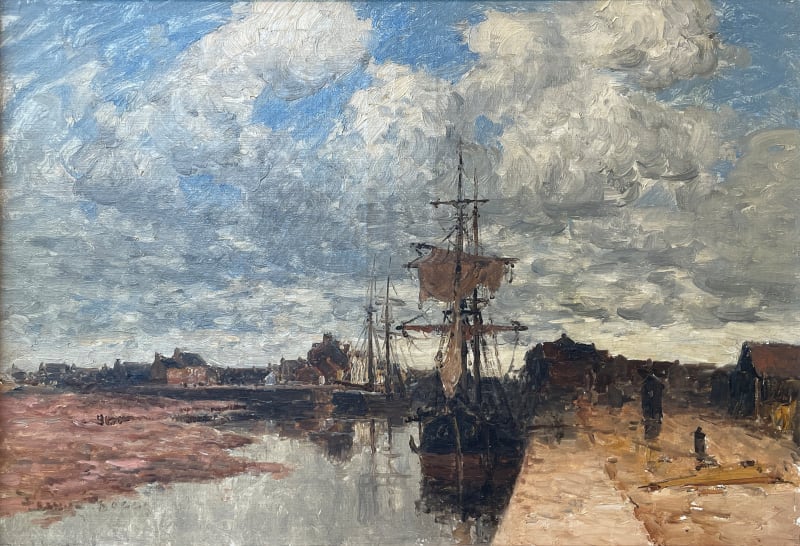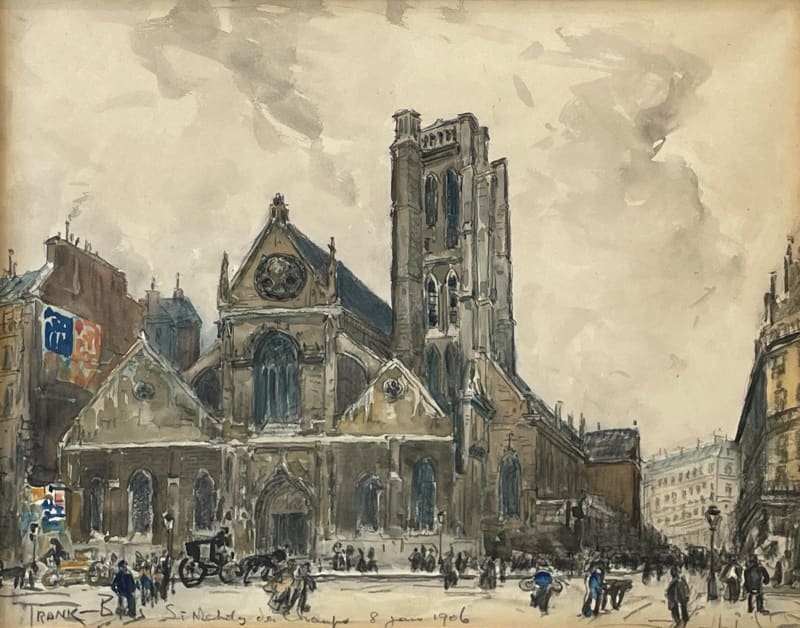The Impressionist Frank Myers Boggs spent his formative and mature years abroad and in 1923 became a naturalized French citizen. He was born in Springfield, Ohio, but moved as a young boy to New York, where his father was a newspaper executive. The artist began his career at the age of seventeen as a wood engraver for Harper’s, preparing illustrations for Harper’s Weekly and for an American edition of the works of Charles Dickens. It has also been stated that he studied with the portraitist John Barnard Whittaker (1836–1926).
After working at Niblo’s Garden in New York with a scene painter named Vauglin, Boggs went to Paris to study scene painting. On his arrival there in 1876, he was unable to find anyone to instruct him in this field and instead entered the École des Beaux-Arts. Realizing that Boggs was not well suited to painting figurative subjects, his teacher Jean-Léon Gérôme (1824–1904) advised him to try some outdoor landscapes. Between 1877 and 1881, he concentrated on marine pictures and harbor scenes in Dieppe, Honfleur, and Grandcamp. Views of architecture and street scenes also fascinated him, and he painted them throughout his career. In 1878 or 1879, Boggs returned to New York. He did much of this painting on Shelter Island and exhibited at the National Academy of Design. His progressive French style, however, was not well received and he soon left again for Paris. In 1880 he began to exhibit at the Salon, and within the next few years, his work was attracting attention both in Paris and London. In 1884, Theodore Child described Boggs as “one of the most successful and one of the most promising of the young American painters in Paris” and lamented that he was not better appreciated in his native land. That same year, the artist spent March and April in New York before leaving for Holland and England, where he continued to work on marine and harbor views.
By the late 1880s, Boggs was acquainted with the Impressionists Claude Monet (1840–1926), Alfred Sisley (1839–1899), Pierre Auguste Renoir (1841–1919), and Eugène Boudin (1824–1898), but his affinity for marine subjects, his use of a somber tonal palette, and restrained impressionist technique better reflect his admiration for the Dutch marine painter Johan Barthold Jongkind (1819–1891), whom he met in Paris at this time. In 1888, on the death of his parents, he returned to New York. He exhibited the following year at the Universal Exposition in Paris and then in 1890 made a trip to Algiers, which precipitated a number of sketches and paintings of Arab themes.
Throughout the next decade Boggs traveled extensively in Europe and frequently visited family in America. He exhibited at the Salon, at most of the international expositions, and in major cities at home and abroad. By 1903 he settled more into Parisian life and two years later moved into an elegant house on the rue de Biraque. He worked extensively in watercolors, many of which depicted architectural subjects, and in 1921 had his first exhibition of etchings. His health failed in 1923, and he died peacefully three years later in Meudon, southwest of Paris. Boggs was awarded the French Legion of Honor posthumously.





